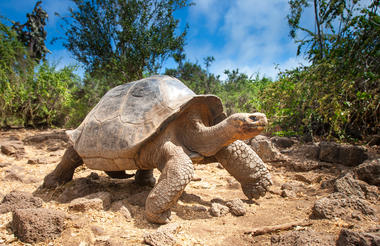Arrival to Baltra Island Airport. Transfer to the boat to meet the guide and get on board. In the afternoon enjoy the highlands, visit a tortoise ranch and see some of the amazing volcanic formations on Santa Cruz.
In the afternoon visit the highlands of Santa Cruz and see the Galápagos giant tortoise in its natural surroundings. Explore the area and its incredible underground lava tunnels – some are more than 1km (.6 mi) long! Wander along the volcanic tubes and keep an eye out for the (mainly) nocturnal barn owls that sometimes roost here.



Lunch
Dinner
In the morning we visit Dragon Hill on the west coast of Santa Cruz to see land Iguanas and a saltwater lagoon frequented by flamingos and other species of birds. In the afternoon, the boat arrives at a small uniquely shaped island off the southern tip of santiago called Chinese Hat. Here it is often possible to see galápagos penguins, and the marine life is fantastic for snorkelling. There is also a large sea lion colony as well as many marine iguanas that can be seen while walking amongst the volcanic scenery. Trek to see good views of the island's volcano.
In the morning visit Cerro Dragón (Dragon Hill) for some prime birdwatching. Take a short walk from the beach to a hypersalinic (saltier than the ocean) lagoon frequented by pink flamingos, common stilts, pintail ducks, and other species of birds. Pass through a Scalesia tree forest; endemic to the area, there are only 400 specimens of Scalesia trees left in the world.
In the afternoon explore Chinese Hat’s beautiful landscape and spectacular white-coral sand beach followed by snorkeling with sea lions and penguins and swimming opportunities in the cove. Snorkel right from the white-coral sand beach and come face to face with playful sea lions and large schools of tropical fish. Keep an eye out for marine iguanas and penguins too!



Breakfast
Lunch
Dinner
Today we will be visiting the beautiful and remote Genovesa Island. This northern island, famous for its red-footed colony, is a paradise for bird lovers. It is estimated that about 200,00 Red-footed boobies live on this island.
El Barranco or Prince Phillips’s Steps as otherwise known, was named after a visit by the British Monarch in 1964. El Barranco's steep 81-foot stairway leads up to a high cliff-face that opens out onto the plateau surrounding Darwin Bay. Here an amazing view can be appreciated. Once at the top of the stairway we will meet Nazca boobies, red-footed boobies, mockingbirds, and finches along the way of a palo santo trail. It will also be possible to see wedge-rumped storm petrels swarm and short-eared owls.
Darwin bay was formed by the collapse of the flooded caldera of Tower Island, another name used for Genovesa. After landing at a small sand and coral beach, it easy to realize why this island is a bird lover paradise. Among the bird species found here, the most common are swallow-tailed and lava gulls, mockingbirds, yellow-crowned night herons, lava herons, Galapagos doves and yellow warblers.
We will continue on a short and flat trail to encounter red- footed booby and great frigatebird nests. We will visit a tidal lagoon where sea lions swim playfully ending our path on a cliff with magnificent views of this remote part of the Galapagos.



Breakfast
Lunch
Dinner
Take a morning panga ride and look for marine life in Black Turtle Cove. Explore the mangroves by panga to find rich marine wildlife between the fresh and salt waters. Keep any eye out for manta rays and sea turtles in this tranquil ecosystem. Whitetip reef sharks can also be seen gliding by. Disembark at Baltra and fly back to Ecuador mainland.



Breakfast







